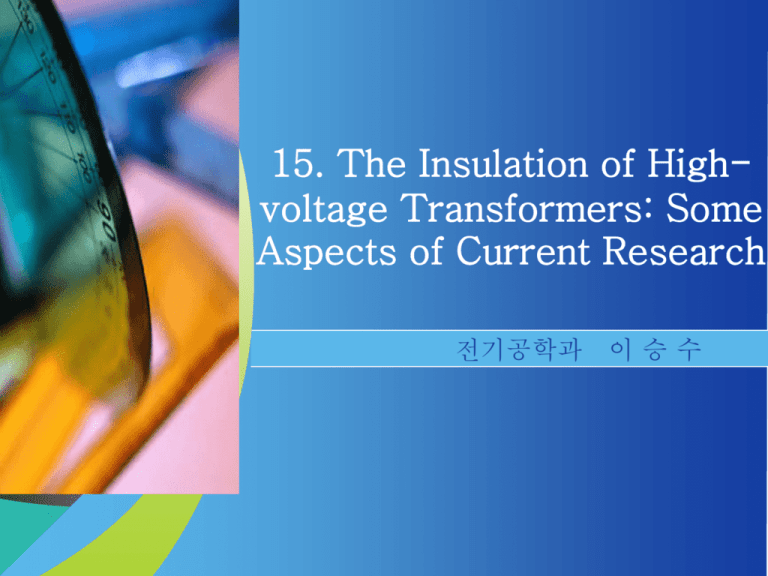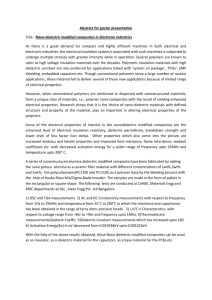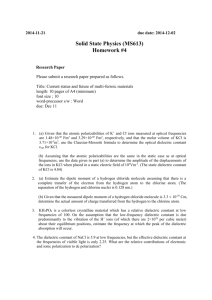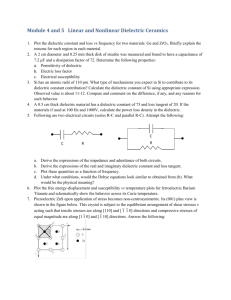Template
advertisement

15. The Insulation of Highvoltage Transformers: Some Aspects of Current Research 전기공학과 이 승 수 Company LOGO 15.1 Introduction 15.1.1 Transformer insulation : basic requirement Specified maximum voltage Transformer Over-voltage of indeterminate magnitudes Lightning and switching operation Insulation of transformer - high-voltage windings increase the overall dimensions - Increased insulation space results in increased size of the windings and core of the transformer - since good electrical insulators are usually poor heat-conductors, the conductors in windings having a high insulation level must generally be run at reduced current densities. Insulating materials Thermal, mechanical and other environmental conditions - the insulation itself, also, represents an appreciable part of the cost of the materials - there is thus a considerable incentive for using the dielectric materials in a transformer with maximum efficiency, thereby minimizing the the quantities required. 15.1 Introduction 15.1.2 Dielectric strength Insulation assembly - usually in transformers, two or three dielectric materials are used in combination Transformer oil Normal stress - dielectric failure, if it occurs, results from the highest local dielectric stress, or voltage gradient, in an insulating medium Residual air pocket Regional high stress Maximum stress Damage breakdown High-voltage test If discharges do occur in oil regions, their consequent high energy may cause deterioration of the surrounding dielectric 15.1 Introduction 15.1.3 voltage conditions Transformer insulation Service voltage Over-voltage Lightning surge 1/50 us ‘full’ impulse ‘chopped’ impulse Switching surge Power-frequency test 15.2 Dielectric strength and dielectric field analysis 15.2.1 tests, test condition and measurements - insulation tests may be in the nature of ‘withstand’ tests, to verify a specified minimum dielectric strength as in commercial acceptance testing Impulse test - breakdown strength is conveniently determined by ‘front of wave’ impulse tests (in which the test specimen break down on the rising front of the impulse) -In impulse tests on dielectric samples with impulses of progressively increasing amplitude, the increments of voltage, and the number of shot applied at each voltage level are significant 15.2 Dielectric strength and dielectric field analysis 15.2.1 tests, test condition and measurements Switching surge - generally considered to have durations of the order 50/1000 ~ 200/5000 us, it has been tacitly assumed that the insulation strength lies between those for power-frequency and impulse voltages -To obtain consistent results in laboratory tests, solid insulation is dried and vacuum impregnated, preferably under standardized conditions equal to the best commercial treatment which can applied. -Transformers in service may operate up to about 90℃ maximum oil temperature. Insulation tests for design purposes may be made over a temperature range from ambient up to 90℃ or over 15.2 Dielectric strength and dielectric field analysis 15.2.2 Partial discharges - at sufficiently high stress, discharges occur in oil or oil-immersed insulation even though no gas cavities are initially present; they will, of course, do so much more readily if incomplete impregnation has left left unfilled air pocket in the solid dielectric. - fig 15.5 shows the effect on the surface of a bakelized paper sheet after 5min gassing discharge in an adjacent 3mm oil gap at the discharge inception voltage -It will be seen that a concentration of stress at the edges of the recessed part of the latch resulted in locally intensified discharge and marked increase in damage 15.2 Dielectric strength and dielectric field analysis 15.2.2 Partial discharges whilst the ‘radio influence voltage’(R.I.V) measurement does not give a correct quantitive indication of the magnitude or energy of internal discharges in insulation transformer (i) gave satisfactory performance ; but in (ii) a flashover subsequently took place in oil, at maximum over-voltage, due to inadequate clearance from a temporary test bushing fitted to a high-voltage cable terminating box 15.2 Dielectric strength and dielectric field analysis 15.2.3 development testing - development testing usually involves carrying out breakdown tests on a number of more or less simple insulation samples representing as closely as possible the insulation -Measurements of breakdown strength on nominally identical insulation test pieces, again, invariably show a considerable dispersion in the result -On the basis of conventional ‘development testing’ (the combination of a large number of tests on component parts of the insulation system, tests on more elaborate insulation assemblies, and tests on complete full-scale prototype transformers) it is necessary to build up a considerable ‘stock’ of design information; and such data can never really be complete so as to cover all future designs. 15.2 Dielectric strength and dielectric field analysis 15.2.4 field analysis approach - By ‘contouring’ of conductors to reduce stress concentrations - by insertion of higher dielectric strength insulation at high stress points - by selection of materials of appropriate permittivities to obtain more uniform voltage gradients 15.2 Dielectric strength and dielectric field analysis 15.2.4 field analysis approach - Since the transformer winding are rotationally symmetrical some small error is caused by ignoring this factor -By far the greatest error arises from the simulation of the high-voltage lead -The high-voltage lead itself on the other hand, being in reality a comparatively small diameter conductor which (away from the high-voltage winding) would considerably disturb the natural field potential only in its immediate vicinity, would be subjected to a high local stress 15.3 Transient overvoltages 15.3.1 surge analysis - Coil 과 earth 사이의 캐패시터 Cg와 연속적인 coil 사이의 캐패시터 Cs의 비율로 서지 전압의 초기 전압 분배 -두 캐패시터가 일정하고 권선 길이 l에 연관되고 ‘space constant’ l / 라고하면 초기 전압은 다음과 같이 나타낼 수 있다. Cg Cs 15.3 Transient overvoltages 15.3.1 surge analysis - 4-uS 간격으로 전압을 인가 - 20 uS에서 한계치 - 비슷한 속도로 되돌아옴. 15.3 Transient overvoltages 15.3.1 surge analysis - ‘chopped wave’ impulse 인가 - 앞쪽 단은 캐패시터에 의해 감소 - 절연파괴를 방지하기 위해 coil edge 부분 강화 - 강화시킨 끝 부분에서 surge impedance의 증가로 인한 impulse 반사파 발생 15.3 Transient overvoltages 15.3.1 surge analysis 15.3 Transient overvoltages 15.3.2 methods of surge investigation -이론적인 분석과 계산 - 실제 모델에 low-voltage impulse 인가, 측정 - high-voltage production impulse test - 인가된 파형의 모습 유지로 절연 파괴 유무 판단 -A, B, C 세 지점에서 인가된 파형과 다름 - low-voltage recurrent surge technique에 의해 절연파괴 의심 지역을 발견 -A 지점에서는 발견 실패 - B, C 지점에서 피크치 발견, 절연파괴 지점과 일치 15.3 Transient overvoltages 15.3.2 methods of surge investigation -Superimposed high-frequency disturbance or ‘smooth’ and identical current waveforms 에 의해 부분방전 발생 - 20 ~ 30 uS에서 다소 과도한 전압 측정 - 부분방전은 impulse test동안 발견할 수 있고 실제 절연파괴 전의 high stress의 증거로 명확함




